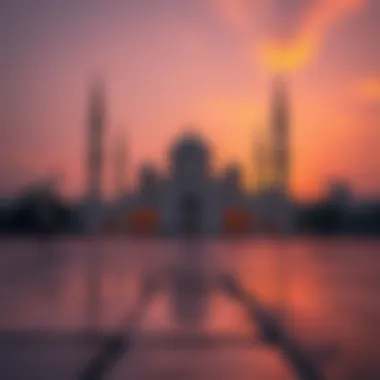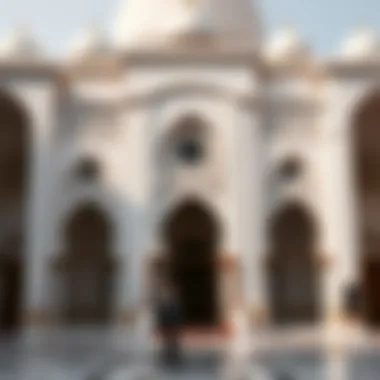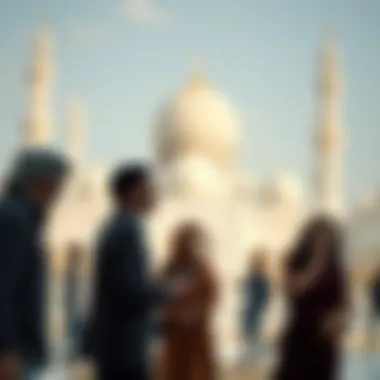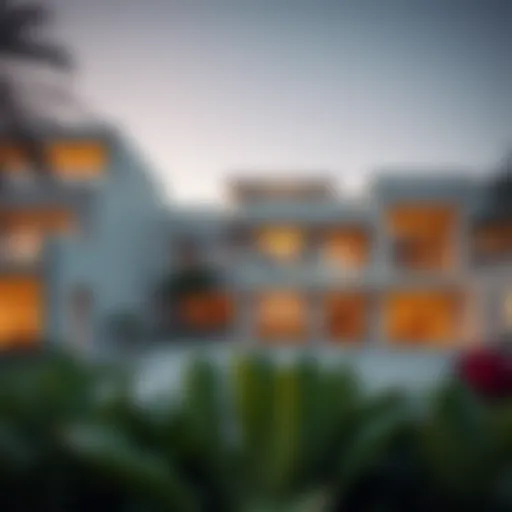Exploring the Cultural Significance of Jumeirah Mosque


Intro
The Jumeirah Mosque holds a unique place in the vibrant fabric of Dubai, standing as an emblem of both architectural grandeur and cultural harmony. This mosque, with its graceful minarets and stunning stonework, showcases the artistry that has flourished in the region for centuries. It provides an ideal backdrop for those wishing to explore not just the Islamic faith but also the multicultural milieu that characterizes modern Dubai.
Open to all, non-Muslims included, it offers more than just a place for worship. The mosque serves as a venue where people from diverse backgrounds converge, engage, and foster understanding — a purpose more relevant now than ever in an increasingly globalized world.
As we peel back the layers of this cultural gem, we will delve into its historic roots, architectural design, and the role it plays in promoting intercultural dialogue. This exploration goes beyond bricks and mortar; it reflects the ethos of a city that thrives on diversity and inclusivity.
With tourism figures climbing and expats migrating to Dubai by the thousands, the relevance of Jumeirah Mosque within this context becomes even more pronounced. It's not merely an architectural achievement; it's a signpost of the changing dynamics in the UAE. Through this lens, we will uncover compelling narratives that shape its identity in the heart of one of the fastest-growing cities in the world.
Engaging with the mosque allows visitors to appreciate a place of worship while also gaining insights into Islamic practices. This article aims to provide a comprehensive tour through the architectural significance and cultural relevance of Jumeirah Mosque, making a case for its vital role in the modern tableau of Dubai.
Moreover, our dialogue will touch on how the mosque nurtures community ties, empowering both locals and visitors to bridge divides. As we embark on this journey, it’s critical to recognize that understanding a culture is about more than just observing; it’s about connecting, experiencing, and sharing. Through the lens of the Jumeirah Mosque, the story unfolds.
As we prepare to explore this enthralling landmark, let’s place emphasis on the interplay of culture, religion, and architecture that Jumeirah Mosque so artfully exemplifies.
Intro to the Jumeirah Mosque
Situated along the beautiful coastline of Dubai, the Jumeirah Mosque stands as a towering testament to the region's cultural and architectural ethos. This mosque isn't just another structure in the vast city; it's a beacon that illuminates the very principles of Islamic art and community gathering. Open to non-Muslims, it offers a unique window into the intricacies of Islamic worship and heritage, making it a pivotal locale for intercultural dialogue.
The Jumeirah Mosque embodies the rich traditions of Islamic architecture, reflecting the aesthetic and spiritual values of its era. Its grandeur resonates through its stunning alabaster facade and intricate detailing, which are hallmarks of the Fatimid architectural style. This design invites both awe and curiosity, encouraging visitors to explore not only its physical space but also the deeper narratives embedded within its walls.
Importance of Exploring Jumeirah Mosque
- Cultural Hub: The mosque's accessibility to the public enriches the cultural landscape of Dubai. As one of the few mosques welcoming non-Muslim visitors, it plays a vital role in bridging cultural divides. Engaging with locals and visitors alike, the mosque fosters understanding and respect among different faiths.
- Architectural Significance: It showcases a blend of traditional Islamic elements with local craftsmanship. The architectural design serves as an exemplary model for studying the evolution of mosque designs in a modern urban context.
- Educational Role: The Jumeirah Mosque conducts regular educational programs and guided tours. These initiatives provide insights into the tenets of Islam, community values, and historical context, highlighting the mosque’s role as an educational resource.
- Tourist Attraction: Beyond religious functionality, it’s a major tourist attraction. Visitors are drawn not just by its beauty but also by the stories it tells, contributing to Dubai's reputation as a cosmopolitan city.
- Community Engagement: The mosque holds events that involve both locals and expatriates, fostering a sense of community. By participating in local events or interfaith dialogues, people can contribute to a foundation of shared experiences and mutual respect.
As we explore the Jumeirah Mosque in detail, we uncover its multifaceted importance, making it not just a religious edifice but a cultural landmark that embodies the spirit of Dubai itself. The ensuing sections will dive deeper into the historical context, architectural features, and cultural significance that define the Jumeirah Mosque's place in both the heart of its community and the broader narrative of Islamic architecture.
Historical Context
Understanding the historical context of the Jumeirah Mosque is crucial for grasping its significance within Dubai and beyond. This mosque isn't just a place of worship; it reflects a rich tapestry of cultural evolution in the region. The development of this structure parallels the rapid transformation that Dubai experienced over the past few decades, showcasing how traditional practices can merge with modernity.
Construction Background
The Jumeirah Mosque was constructed in 1976 and is one of the most photographed landmarks in Dubai. Designed to reflect the classical style of Fatimid architecture, it employs white stone, giving it a serene and majestic appearance. This mosque stands out not just because of its beauty, but due to its multifaceted role within the community.
The choice of location wasn't arbitrary. Jumeirah, being an affluent area, symbolises both Dubai's growth and its dedication to cultural inclusivity. The mosque was built during a time of great prosperity for the emirate, which saw an influx of expatriates. This demographic change prompted the need for a religious structure that could accommodate a diverse range of communities, thus enriching Dubai’s social fabric.
Moreover, the mosque also acts as a beacon of Islamic architecture, illustrating how traditional elements can maintain relevance in a rapid-paced urban environment. The intricate designs and towering minarets evoke a sense of history that resonates with both locals and visitors alike.
Evolution of Islamic Architecture in Dubai
Islamic architecture in Dubai has its roots deeply embedded in history, yet it has evolved significantly over time. From the humble structures of the past to the grand edifices of today, the architectural landscape of Dubai illustrates a narrative of change. The Jumeirah Mosque epitomises this evolution, bridging old traditions with contemporary sensibilities.
Historically, Islamic architecture throughout the region is characterized by the use of geometric - often complex - patterns, vibrant colors, and intricate tile work. Even though newer constructions lean towards a sleek, modern aesthetic, the Jumeirah Mosque embraces traditional artistry. Its design reflects Islamic principles while accommodating the needs of a growing city.


Dubai's journey from a modest fishing village to a global city has necessitated an architectural dialogue that respects tradition while embracing innovation. This mosque symbolizes a harmonious blend of both worlds.
Through the lens of the Jumeirah Mosque, one can observe how Islamic architectural practices have adapted—balancing the intricacies of ancient designs with the demands of contemporary life. The mosque not only serves as a house of worship but as a gallery of architectural history and cultural dialogue.
In summary, the historical context enables us to appreciate the Jumeirah Mosque not simply as a physical structure but as a pivotal marker in Dubai's dynamic cultural landscape.
Architectural Features
The architectural elements of the Jumeirah Mosque are not just about aesthetics; they embody a narrative that reflects the spiritual and cultural essence of Islam interwoven with Dubai’s modernity. As one of the few mosques in Dubai that welcomes non-Muslims, the design plays a crucial role in fostering intercultural exchange and understanding. The mosque stands as a remarkable example of Islamic architecture, bridging traditional artistry with contemporary functionality.
Mosque Design and Structure
The design of the Jumeirah Mosque is characterized by its stunning large dome and intricate minarets, which rise gracefully against the Dubai skyline. Built in the traditional Fatimid style, every element serves a purpose, from the grand entrance to the expansive prayer hall. The structure is symmetrical, drawing the eye towards the central dome which signifies unity and the omnipresence of the divine.
Inside, the soft glow of light filtering through the stained glass enhances the spiritual ambiance. This design invites contemplation, emphasizing an experience rather than just a visit. The architecture is not just a shelter for worship; it is a space for communal gathering, dialogue, and cultural enrichment.
Materials Used in Construction
Constructed from local limestone, the mosque features a durability that complements the hot climate of Dubai. The use of this locally sourced material not only supports sustainability but also reflects the environmental consciousness prevalent in contemporary architecture. The craftsmanship is apparent in the meticulous carvings and decorative motifs that adorn both the interior and exterior of the mosque. These motifs often draw inspiration from the flora and fauna native to the region, highlighting a connection between the mosque and its geographical surroundings.
Additionally, the presence of traditional Islamic calligraphy throughout the mosque creates a serene atmosphere. The interplay of shadows and light, created by the patterned windows, adds a breathtaking visual dynamic, making each visit unique.
Symbolism in Design
In Islamic architecture, symbolism is paramount. The design of the Jumeirah Mosque integrates various symbols that relate to spirituality and community. The multiple arches are a demonstration of an open heart, welcoming all who enter, while the central dome reflects heaven, emphasizing the connection between the material and spiritual worlds.
The minarets, towering above the surrounding structures, are not just functional; they represent the call to prayer, a reminder of the divine presence in daily life. Overall, every piece of architecture tells a story, imbuing the mosque with a sense of purpose and significance that resonates beyond its physical presence.
The Jumeirah Mosque is a testament to Dubai's dedication to celebrating its Islamic heritage while promoting understanding and respect among diverse cultures.
In summary, the architectural features of the Jumeirah Mosque stand as a hallmark of Dubai’s cultural narrative. It not only attracts visitors for its beauty but also serves as a powerful tool for education and community engagement. Through thoughtful design, careful material selection, and layered symbolism, the mosque invites inquiry and appreciation from all who take the time to explore its depths.
Cultural Significance
The Jumeirah Mosque stands as a pivotal cultural symbol in Dubai, transcending its role as merely a place of worship. This majestic structure embodies a myriad of cultural narratives that resonate deeply within the community and beyond. Primarily, it signifies a space for intercultural engagement, where individuals from diverse backgrounds come together to learn and discuss the values and traditions that form the bedrock of Islamic culture. The mosque serves as a practical demonstration of the tolerance and openness that characterize the Emirati culture, inviting non-Muslims to explore and engage, which is a rarity in many parts of the world.
Role in Community Engagement
At its core, the Jumeirah Mosque actively participates in community engagement, acting as a bridge between different cultures. The mosque offers various programs aimed at fostering understanding among residents and visitors alike. Guided tours, often led by knowledgeable hosts, encourage dialogue and questions about Islamic practices and beliefs. Such interactions break down barriers and challenge misconceptions, guiding visitors through an enriching experience that often leads to a greater appreciation of the values upheld within Islamic traditions.
Regular community events organized at the mosque are designed to draw in local residents and visitors, uniting them under the shared goal of understanding. These initiatives not only promote the mosque itself but also foster a sense of belonging among participants. Thus, it becomes a hub for cultural exchange, where discussions lead to mutual respect and deeper appreciation of diversity.


Interfaith Dialogue and Education
In line with promoting community engagement, Jumeirah Mosque plays a crucial role in facilitating interfaith dialogue and education. Through dedicated programs, it welcomes individuals from all faiths, seeking to educate them about Islamic principles and traditions. The mosque often hosts workshops, seminars, and panel discussions focusing on various aspects of Islamic culture, emphasizing its teachings that often align with universal values such as compassion and community welfare.
“The mosque is not just a place of prayer; it’s a place of gathering, understanding, and learning.”
Such dialogues extend beyond mere conversation. They invite participants to explore joint community initiatives that emphasize cooperation, showcasing how shared values can unite different faiths towards a common purpose. The educational aspect is not limited to lectures; it often includes interactive elements, allowing participants to engage actively rather than merely listen.
The cultural significance of Jumeirah Mosque is amplified through these avenues of engagement and education. Each interaction encapsulates a broader narrative about coexistence, laying down groundwork for a future where diversity is celebrated and cultural boundaries are softened.
Visitor Experience
The visitor experience at the Jumeirah Mosque is paramount, serving not just as an entry point for tourists, but as a bridge promoting understanding among different cultures. Engaging with this architectural masterpiece goes beyond simply admiring its intricate design; it's about entering a space that holds profound significance for the local Muslim community while inviting non-Muslims to engage and learn.
When one steps into the Jumeirah Mosque, they aren't just crossing a threshold into a religious site, they are actually partaking in a unique journey of discovery. The mosque's structured guided tours add tremendous value, providing insights about Islamic traditions, values, and the mosque's architectural details. The programs often emphasize the mosque's role as a focal point for cultural interaction, showcasing the openness of Dubai as a cosmopolitan city.
Guided Tours and Educational Programs
Guided tours at the Jumeirah Mosque are designed to enhance the visitor experience, allowing guests to appreciate the deep layers of history and spiritual significance embedded within its walls. Each tour is typically led by knowledgeable guides who are often fluent in multiple languages, making the experience accessible to a broader audience. Topics commonly addressed during these tours include the architectural influences seen in the mosque's design, its historical context, and its significance in the Islamic faith.
These educational programs stand out for their focus on dialogue and sharing knowledge, breaking down barriers between cultures and fostering a sense of community. Visitors have an opportunity to ask questions, explore intriguing aspects of Islamic culture, and understand how these elements resonate with everyday life in Dubai. The ability to participate directly enriches the experience more than mere observation ever could.
Etiquette and Guidelines for Visitors
To fully enjoy the experience at the Jumeirah Mosque, it’s crucial for visitors to be aware of the etiquette and guidelines that accompany such a sacred space. Firstly, modest dress is a must. Women are often required to wear an abaya, which is sometimes provided by the mosque. Also, covering shoulders and knees is advisable for all. Men should avoid wearing shorts or sleeveless shirts.
In addition to dressing appropriately, maintaining a respectful demeanor is essential. This includes refraining from loud conversations and photography during prayers or any rituals. Visitors can also participate in the offered "ask a question" sessions where they can inquire about Islamic traditions and discuss personal perspectives.
"The Jumeirah Mosque is not just a place of worship; it's a gateway to understanding the rich tapestry of Islamic culture and hospitality."
Ultimately, the importance of understanding etiquette cannot be overstated. Respecting customs enhances not only the visitor’s experience but also fosters good relations between varying cultures. By being aware of these protocols, visitors contribute to an atmosphere of mutual respect, making their time at the mosque even more enriching.
Impact on Dubai's Identity
The Jumeirah Mosque is not merely a physical structure; it stands as a representation of the intricate identity of Dubai. As a harmonious blend of rich tradition and modernity, the mosque contributes significantly to the city's cultural narrative. This section reflects on how the mosque reinforces Islamic heritage and guides contemporary architectural trends in the region.
Representation of Islamic Heritage
At first glance, the Jumeirah Mosque embodies the very essence of Islamic heritage. Its design, characterized by intricate carvings and beautiful arches, mirrors a profound reverence for traditional Islamic architectural styles found around the world, yet it maintains a unique identity that is distinctly Emirati.
The mosque serves as a reminder of the city’s roots, showcasing not just artistry but also a deeper cultural narrative. The whole construction, made predominantly of white stone, reflects the sun's rays, creating an inviting symbol of peace and light in this vibrant desert city. The architecture draws connections to historic mosques like the Ibn Tulun Mosque in Cairo while intertwining elements unique to the United Arab Emirates, reinforcing its position as a key symbol of Islamic culture in a rapidly developing metropolis.
Furthermore, the Jumeirah Mosque is a live canvas of Islamic teachings, showcasing verses from the Quran inscribed artistically within its walls. These inscriptions serve not just an aesthetic purpose . They play a significant role in educating both locals and visitors about the principles of Islam, bridging cultural divides and fostering understanding.
Sustainability and Environmental Considerations


In recent times, the dialogue around sustainability and environmental considerations has gained unprecedented importance globally. For cultural landmarks like the Jumeirah Mosque, this aspect is not merely an afterthought; it is a core aspect that enhances its legacy and relevance in contemporary society. Embracing eco-friendly practices not only safeguards the environment but also sets a precedent for future constructions.
Eco-friendly Practices in Mosques
Mosques around the world are increasingly adopting eco-friendly practices, and the Jumeirah Mosque is no exception. The integration of sustainable features into the mosque's operation and design illustrates a commitment to preserving resources for future generations. For instance, the use of energy-efficient lighting helps significantly reduce electricity consumption. Moreover, water conservation is addressed through the installation of low-flow fixtures, which minimize water waste.
Another noteworthy practice is the choice of materials used during construction. Locally-sourced materials not only support the regional economy but also reduce the carbon footprint associated with transportation. Plus, opting for durable materials ensures longevity, reducing the need for replacements and, consequently, waste.
"Sustainability is not a trend; it’s a responsibility that falls on every community member, especially places of worship."
In essence, these green practices contribute to an environment where worshippers can connect with spirituality amidst a backdrop of ecological mindfulness.
Preservation of Cultural Sites
Preserving cultural sites like the Jumeirah Mosque goes hand-in-hand with environmental sustainability. Historic structures serve as vital links to the past, enriching modern society with stories, architecture, and aesthetics that define a community. Therefore, safeguarding these iconic landmarks ensures that they continue to be a source of pride and cultural identity.
Efforts to maintain the Jumeirah Mosque include routine inspections and maintenance that prioritize original materials and craftsmanship. This approach not only protects the mosque’s aesthetic integrity but also minimizes the environmental impact of excessive renovation. By following environmentally-friendly conservation practices, it preserves cultural heritage without compromising the sustainability goals.
In summary, the Jumeirah Mosque is a model for sustainability. By adopting eco-friendly practices and preserving cultural heritage, it plays a pivotal role in Dubai's identity, resonating with locals and tourists alike. This commitment to sustainability enhances the mosque's significance, transforming it into a living, breathing entity that continues to engage and educate, while remaining respectful to the environment.
Future of the Jumeirah Mosque
The Jumeirah Mosque stands as a beacon of cultural interchange and architectural grace in Dubai. Its future is not merely about preserving a structure; it is about safeguarding the soul of a community and enriching the cultural vibrancy of the region. As Dubai continues to grow, adapting to change while honoring tradition is vital. Here’s a closer look at the plans for its renovations and the ongoing contributions to the community.
Plans for Renovations and Upgrades
Future renovations at the Jumeirah Mosque are aimed at reinforcing its position as a premier cultural hub. These renovations include technological upgrades and improvements in accessibility to ensure that all visitors, regardless of ability, can engage with the mosque’s beauty. The plans also involve the use of sustainable materials and practices, carefully navigating the path of eco-friendliness while maintaining the mosque’s iconic design.
- Enhancement of Facilities: This involves upgrading visitor centers to provide more educational resources for tourists and locals alike. These centers will include more interactive exhibits highlighting the mosque’s history and cultural significance.
- Green Initiatives: The mosque is exploring ways to incorporate solar energy into its systems. Solar panels may grace the rooftops, capturing the abundant sun to power lighting and other needs of the facility. This integration not only saves energy but also mirrors the environmental values the region seeks to promote.
- Renovation of the Exterior: To maintain the stunning aesthetic appeal, plans for periodic restoration of the mosque's facade will take place. This step ensures that the intricate carvings and designs remain striking and true to their original form.
“Preserving the past while embracing the future forms a cornerstone of cultural heritage.”
Ongoing Community Contributions
The Jumeirah Mosque’s community initiatives are as essential as its architectural splendor. These contributions weave the very fabric of connection and understanding among diverse groups. Several programs are in place:
- Education Programs: Workshops and lectures are frequently held to educate both locals and visitors about Islamic culture, enhancing mutual understanding. These sessions often invite knowledgeable speakers who share insights about the mosque’s role in the community and its broader significance in Islamic traditions.
- Cultural Festivals: The mosque participates in various cultural festivals, celebrating events that attract people who might not otherwise visit. These gatherings provide a platform for intercultural dialogue, fostering respect and understanding among different cultures.
- Volunteer Opportunities: Engaging the community through volunteer programs not only helps maintain the mosque but also builds relationships among attendees, creating bonds that transcend cultural divides.
In essence, the future of the Jumeirah Mosque isn't just about bricks and mortar; it’s about the ongoing dialogue it fosters. By focusing on sustainability, modernization, and community engagement, the mosque can continue to serve as a pillar in Dubai’s broader narrative, guiding both residents and visitors towards a deeper understanding of Islamic culture and tradition.
Finale
The Jumeirah Mosque stands as more than just an architectural marvel in the heart of Dubai. It serves as a beacon of understanding, bridging cultures and faiths through a unique lens of appreciation and respect. The intricate details of its design, coupled with its historical significance, contribute not only to its immediate environment but also to the broader narrative of Dubai's cultural identity.
In this exploration, several key elements emerge:
- Cultural Connector: The mosque's model of intercultural dialogue invites visitors from various backgrounds to engage in meaningful discussions about Islamic traditions and values. Such interactions are invaluable in a globalized world where misunderstandings often arise from a lack of direct engagement with different cultures.
- Architectural Fusion: The blend of Islamic design principles with local elements creates a unique representation of Dubai’s evolving architectural style. This mosque captures the essence of Islamic architecture while demonstrating adaptability to contemporary aesthetics, reflecting the dynamic nature of the city itself.
- Community Role: It actively promotes community interaction, offering educational programs that cater to both residents and tourists alike. This not only enhances religious understanding but also contributes to a sense of belonging among diverse populations.
- Future Considerations: As challenges and opportunities arise in urbanization and tourism, the mosque’s commitment to sustainability and inclusivity will play a pivotal role in shaping its future. Continuous renovations and the integration of eco-friendly practices will ensure that it remains relevant and accessible for generations to come.
"To be at the mosque is to sit in a space where heritage meets hospitality, where tradition opens the door to dialogue."
For more information about the Jumeirah Mosque and its initiatives, resources such as Wikipedia, Britannica, and local government websites can provide further insights.















